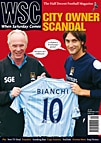 The poor technique of British kids demands action – money-making, patronising action, focusing on the individual ahead of the team and fronted by a clone of Barry from EastEnders. David Stubbs is impressed
The poor technique of British kids demands action – money-making, patronising action, focusing on the individual ahead of the team and fronted by a clone of Barry from EastEnders. David Stubbs is impressed
It is commonly acknowledged, except, apparently, among the people charged to do something about it, that there is a skills deficit among young British footballers. Despite years of berating from the sidelines, tournament after tournament sees Our Boys shown up, even in the preliminary games they end up winning, as lacking in the simple but delicate arts of the game. A blood-and-thunder philosophy still prevails. The ball is not passed but “got rid” of. Players puff their chests, as if prepared to run through walls on request, charge about like lions on heat for the first 20 minutes of every game, then “mysteriously” run out of energy after an hour. Meanwhile, international opponents expend a fraction of the effort to much the same effect by simple dint of having the confidence in their ability to control and stroke about the ball.
From that viewpoint, the “Trick-Sok” is, on the face of it, a welcome initiative (well, commercial enterprise, so a maximum of two possible cheers). The pack consists of the “Soks”, with a demonstration DVD that shows you how to learn “beat-moves” (yes, there’s a lot of this), “skills and tricks” and generally emulate Ronaldinho, Luis Figo et al. As the opening rap on the DVD, conducted by a Caucasian cockney in a T-shirt of many colours, has it: “What’s all the fuss about the sock? Well, go and buy one down at the shop!” And the other one, while you’re at it. They come as a pair, you know.
The “Sok” is a one-size, rubber attachment that you stretch over your boot. It’s divided up into various zones with words like “LIN” and “RO” and “LEBAK” inscribed, which indicate the various parts of the foot. “LIN” is left instep, “RO” is right outside, “LEBAK” is left bak – sorry, back as in heel. Alluded to as the “language of the street”, this is intended as a training aid, to be referred to as you go through the various exercises that comprise the rudiments of ball control, and then, as you progress quickly, more advanced, tricksier skills.
Now, with its graffiti-type graphics, its arbitrary use of the word “street”, its aversion to the letter “c”, presenters addressing us through entirely superfluous mics, even when talking to the kitted lads demonstrating the moves stood but two feet away from them, terms such as “extreme freestyle” and promises that wearing of the Sok will “command respect”, it’s quite clear at whom this DVD is aimed. That’s right, young, white suburban kids. Among the participants and presenters here, the black face count is as high as that in a 1949 Stanley Matthews’ Bumper Soccer Book For Boys annual. One of the presenters, who looks like “Barry from EastEnders” of Extras fame, cuts an especially pitiful figure. He talks of “dreaming to be like Ronaldinho”, but his own dream is clearly to be part of a novelty, one-hit rap duo, a dream sorry in a man of his circumference.
Most of the DVD is taken up with practical exercises, and these are simple but sensible enough, the staple of any basic, academic football training. You learn how getting the ball to do a variety of things means using various bits of the foot, rather than hoofing and hoping. Fine. The question is never raised, let alone answered, of why mastery of these skills requires the consultation of a rubber sock, but perhaps it’s too early to judge whether the device truly aids concentration. My “Soks” will be donated to my 12-year-old nephew, and he will provide feedback at some future date.
What is cause for concern is that the “Trick-Sok” ethos is wholly individualistic. “Freestylin’” is code for showing off, while demonstrations see the kids pitted against each other one on one. The aim, according to Trick-Sok’s blurb, is “having the skills available at your feet to totally destroy and humiliate your opponents – the ultimate power”. Hmmm. One doesn’t wish to come on too schoolmasterly here, but all this negates the importance of football as a team game. One in which you pass the ball to your fellow players, rather than prat around on the touchline in the “freestyle zone”. Indeed, in its 12-step programme there is no mention of passing the ball whatsoever.
Ultimately, this a risible, cynical attempt to speak to a youth supposedly desocialised by games consoles and gangsta rap fantasies of individual domination – to put the “arse” into sole.
From WSC 247 September 2007